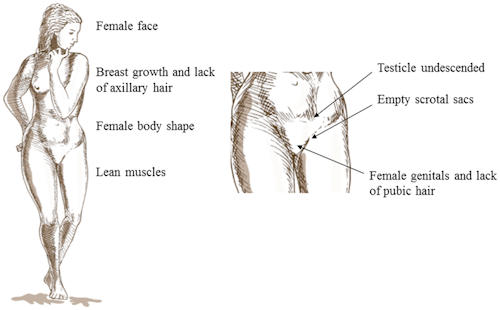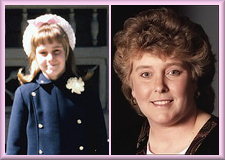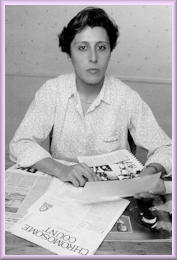|
Introduction Many thousands of women around the world suffer from a disorder known as Androgen Insensitivity Syndrome (AIS), or in old textbooks as Testicular Feminisation Syndrome. Perhaps 1 in 20,000 women are affected. The syndrome is of great interest because it proves (though perhaps not to some judges and lawyers) that women can have XY genes, a fact which has considerable significance for genetically XY Male-to-Female (MTF) transsexuals. Some women diagnosed with AIS actually suffer from the even rarer Swyers Syndrome.
Unlike with MTF transsexual women, no court has ever disputed the right of an AIS woman to legally marry a man and adopt children on the grounds that she's actually genetically XY male. However, an adult AIS woman is physically (internally and externally) almost indistinguishable from a MTF transsexual woman who started surgical and hormonal treatment before puberty, so clearly there is a major issue and injustice here.
Medical
Background of AIS
There are two
types of AIS: most (90%) suffers have completely normal female type
external genitalia but they lack a uterus and upper vagina. This
is known as Complete AIS (CAIS), technically AIS Grades 7 &
6. The remaining (10%) of suffers have Partial AIS (PAIS),
their outward genital appearance varying from almost
completely female (AIS Grade 5) through to almost completely male (Grade
1).
Decades of medical studies show that very few AIS suffers doubt their female gender. An important exception is that for the rarest types of PAIS (AIS Grades 1 and 2) the external genital deformity is so minimal that a baby's gender assignment will be male. Excessive breast development is likely to unexpectedly occur at puberty, but this can be removed by surgery and a few Grade 1 PAIS males are even fertile.
Incidence The most accurate figure available for the incidence of CAIS comes from a 1992 analysis of a Danish patient register, suggesting an incidence of 1 in 20,400 XY births. This includes hospitalised cases only, so the true incidence is probably higher. PAIS seems to be only about 1/10 as common as CAIS.
Anne Fausto-Sterling in her excellent book, Sexing the Body: Gender Politics and the Construction of Sexuality, suggests that the actual incidence of AIS is about 1 in 10,000 - which would imply up to 3000 people (male and female) suffer with CAIS or PAIS in the UK alone. As support groups and surveys have identified only about 500 such people in the UK, clearly there is still a major hidden problem.
Puberty
Shortly after puberty starts, an orchiectomy will often be performed to remove the testes (primarily to reduce risk of cancer), and Hormone Replacement Therapy begun to substitute for the oestrogen that the testes were producing. In appearance the overall body shape typically becomes very decidedly feminine, with a classical female pattern subcutaneous fat distribution and generous breast development - large breasts with pale, under-developed, juvenile appearing nipples are one indication of AIS. Girls with CAIS will either fail to develop pubic and auxiliary hair (AIS Grade 7), or it remains scant (Grade 6).
Sexual Orientation Studies have found that most, although certainly not all, women with complete androgen insensitivity syndrome (CAIS) have no problems with their female gender identity and unambiguously identify themselves sexually as a woman, often leading normal sex lives. Statistically their leanings towards heterosexuality, lesbianism or bisexuality may be no different from females in general.
However, it must also be recognised that AIS women have both physical and psychological factors that might predispose them to suffer sexual dysfunction, e.g.: shorter than average vaginas, an inability to respond to androgens and anxieties or concerns about their condition, which could impact on self-esteem, body image, sensuality and sexual function. At least one study found that sexual dysfunction is common in CAIS, most significantly in the areas of difficulty with vaginal penetration, infrequency and non-communication. A rough analysis of biographies and articles published on the Internet by or about AIS women shows that while many are married or strongly attracted to men, an unusually large proportion have a lesbian or bisexual orientation. But there may well be a bias in these results compared with the actual situation. Speculating considerably, a lesbian or bisexual orientation may be more prevalent in PAIS (rather than CAIS) women where greater social, physical and biological challenges to their female psychosexual sexual identity have occurred at a young age, these problems may have made such women more likely to openly state their situation and adopt an activist position than a far more numerous group of happier and often married heterosexual women who are reluctant to publicise their AIS condition.
The external genitalia (vulva) of a CAIS women is completely identical to that of a normal CIS-woman, both in appearance, structure and sensations. Given adequate vaginal depth there is no reason for a CAIS woman and her partner not to enjoy sexual intercourse just as much as any other couple. CAIS women typically have a a short, blind-ending, vagina (averaging 5-6 cm long, about half normal size but with great variance), which is rather too short for satisfactory penetrative sexual intercourse with a man. In general the best method involves dilation, in which a doctor or nurse teaches the young woman how to use an instrument called a dilator to put pressure on the inside of her vagina, gradually stretching it. The girl should start dilation only when they feel psychologically ready, usually between the ages of 15 and 20 and contemplating entering into a sexual relationship with a man. Over a few months of daily exercises, the vagina becomes deeper and wider, making intercourse possible. Surgical procedures can also be used to lengthen the vagina, but as surgery has more complications than dilation it is avoided if possible. It's unfortunately not quite so simple for a PAIS woman. Almost all PAIS women are born with an enlarged penis/clitoris, a partial obstruction to the vaginal opening, and little or no vaginal depth. However it usually only requires a minor genitoplasty procedure to tidy up the vulva area and make it indistinguishable from a cis women, and to open up the vaginal opening for dilation.
Adoption is by far the most realistic option if a woman with AIS wants to become a mother. Compared to transwomen they have a huge advantage in that they have a female Birth Certificate, they were brought up as a girl, they mentally consider their gender to be female, and physically they are externally completely female. One small study of 12 AIS women found that 10 had adopted at least one child, some as babies. Eden Atwood and her adopted son Ben is a high-profile confirmation of this. Many other AIS women have become the stepmother of children fathered by their husband. Advanced new fertility treatments are starting to offer significant hope for AIS women desperately wishing to get pregnant and have children. For example, uterus transplants and the creation of eggs with DNA extracts are all progressing, but they seem many years away from becoming bookable procedures.
Appearance Due to the lack of androgen affects the girl will not suffer from acne or temporal hair loss, and little or no pubic hair and auxiliary body hair will develop at puberty.
The overall effect is that AIS women tend to be exceptionally beautiful with above average height (for a woman), long and well-proportioned legs, generous breasts, good teeth, exceptionally clear skin and thick scalp hair. According to one paper the AIS woman is "often voluptuously feminine", another report says "some people with the syndrome look like 'mama mia' women", and even John Money and A. Ehrhardt in their famous book Man and Woman, Boy and Girl noted that AIS girls tend to have a "very attractive female physique".
It's been reported "because they [AIS women] are unusually beautiful, they are usually found in occupations that pay high salaries for attractive female appearance such as modelling, acting or prostitution". This is supported by other AIS studies, for example one study found that several top fashion models and two well-known [though unnamed] Hollywood actresses had AIS, an Australian study concluded that "many girls work as models", and another report noted that one of the girls it had studied was an (unnamed) famous photographic model, two were air stewardesses and one a prostitute. "In the old West, women with AIS were reportedly popular among the ranks of prostitutes," notes Vikki Huffnagel, a Californian obstetrician/gynaecologist who treats AIS patients. "They were tall, lean, very attractive, and couldn’t get pregnant." Despite the above comments, it is certainly an extreme exaggeration to suggest that every AIS woman is a potential supermodel. Nevertheless, it seems that the physiological traits associated with AIS make suffers above average in their attractiveness to men.
Famous Woman with AIS The first historical description of a woman apparently suffering from Androgen Insensitivity Syndrome is in the book Talmud, which dates back to BC400. Other women suspected (based on limited evidence) to have had AIS include:
Sam Berry, Emeritus professor of genetics at University College London, has also speculated (Daily Telegraph, 21 November 2001) that the Virgin Mary had Androgen Insensitivity Syndrome, but with differentiation of her sex organs. He claims that it is possible for a person of this constitution to develop an ovum and uterus, "If this happened, and if the ovum developed parthenogenetically [i.e. unfertilised - common in some animals], and if a back-mutation to testosterone sensitivity took place, we would have a situation of an apparently normal woman giving birth without intercourse to a son." In America, the notorious Black Dahlia murder case (the basis for a movie released in 2006) may sadly be related to a AIS condition. The Black Dahlia (aka Elizabeth Short ) was a beautiful and popular 22 year-old waitress whose body was found horribly mutilated and dismembered in Los Angeles in 1947. The terrible murder has never been solved, but a leading theory is that the murderer was a suitor who became enraged when he discovered that she had an underdeveloped vagina. A close acquaintance claimed that Elizabeth never menstruated but used sanitary napkins to try to conceal this. The autopsy report focused only on the extensive injuries to her limbs and breasts. She wasn't examined internally - leaving it inconclusive whether Elizabeth actually had AIS. As already indicated, medical papers frequently mention that various famous but unnamed (except via pseudonyms) actresses and models have AIS. The rumours are often fanned by semi-reputable sources, e.g. a link on medhelp.org claims that "there are at least two well-known American movie stars who are XY women". A popular gossip website posed the question "which Oscar-winning Hollywood superstar’s doctor claims she was born a hermaphrodite, with undescended testes where her ovaries should have been? (and no, it’s not Jamie Lee Curtis)". Unsubstantiated suggestions were Charlize Theron, Frances McDormand, Hilary Swank (who all have only adopted children) and Renée Zellweger.
For obvious and understandable reasons, women with the AIS disorder are very unlikely to admit or confirm that they have it (Eden Atwood is a rare and brave exception), while women mistakenly alleged as having AIS are very unlikely to submit to the indignity of medical examinations and karyotype testing for XY genes in order to convincingly disprove it. Nevertheless, speculation and rumour about possible famous women who have AIS is rife in popular magazines, newspapers, and particularly on the web - usually backed up with little or no real evidence other than lack of children. For example, a search of the internet (12 April 2008) suggests as possibly having AIS the ultimate female icon Marilyn Monroe, and other actresses such as Katherine Hepburn, Jessica Biel, Daryl Hannah and Adriana Catano. Actress Nicole Kidman also often appears, despite her admission that she was seeking help for fertility issues - "I’ve done all the stuff you can possibly do to try get pregnant" - happily she subsequently seems to have been the natural mother of at least one child.
Supermodels are often rumoured to have AIS because they fit the stereotype of the syndrome very well - tall, slim, generous bust, wonderful complexion, voluminous hair, big smile, very pretty and attractive, but not delicate and petite. Essentially any top female model reaching 35 without children is susceptible to rumours that she has AIS, or is even a transsexual - rumours which are often disproved. For example, Cindy Crawford was a victim of the rumour mill in the mid-1990's, but gave birth to a son in 1999 (age 33). Gisele Bunchen is another example, rumours that she had AIS were starting to become widespread when in 2009 (age 29) she became pregnant and had a son, Benjamin. But the rumours are not always wrong. After considerable sepeculation that she was transsexual, in January 2017, Belgium born model Hanne Gaby Odiele bravely disclosed that she had AIS in the hope that this would help to break the stigma around the topic and support intersex children. She had her testes removed age 10 to avoid testicular cancer, and surgery age 16 to create a vagina. Her modest breast development and the need to create a vagina suggests that she has partial (Grade 4 or 5) rather than complete AIS.
As already mentioned, the actress Jamie Lee Curtis is very frequently cited as an example of a woman with AIS. She has never confirmed this, but there is an unusual amount of 'smoke' in this instance. Every time a medical study says that an unnamed famous actress has AIS, Jamie is always associated with this. [Jamie deserves her privacy, but the speculation is too widely diseminated to not consider it being in the public domain]. A confidential document from her medical records was apparently briefly leaked which stated that she was born with Partial AIS Grade 3. If true she would have required plastic surgery similar to that undergone by MTF transsexuals to normalise her genitalia as female and create a neo-vagina. Jamie adopted a young girl (Annie) in 1986 and newborn baby boy (Thomas) in 1996. In 2021 Jamie revealed that Thomas had outed herself as being transgender and had transitioned, and was now her second daughter, Ruby. Finally for this section, a movie siren of the 1950's and '60's, Kim Novak, is alleged to have AIS. Like Jamie, there is no hard evidence for this, and the incidental evidence is upon analysis limited to fact that she has never had children. Given her lengthy series of lovers and husbands and the limited surgical techniques available at that time, if true then she was presumably born with Complete AIS and had adequate vaginal depth for satisfactory sexual intercourse.
In the late 1960's sex chromosome testing was introduced for top female athletes in many sports as it was increasingly suspected that some of the most successful athletes from the Soviet Union and Eastern Europe had been born male due to their masculine characteristics. Many top female athletes indeed suddenly ceased to compete rather than take the test. However, the tests unexpectedly started to identify as "male" athletes that no one had ever before doubted as being female.
The first high profile occurrence was in 1985 when top hurdler María José Martίnez-Patiño was suddenly excluded from female sports when she failed a test due to having AIS. As the years passed, it became clear that almost all the women failing female chromosome tests had AIS. Reportedly 1 in 500 women athletes of international elite standard suffer from AIS, which is an order of magnitude greater than current estimates that about 1 in 5000 women in the general female population have AIS. AIS women are obviously genetically XY male, and allowing them to compete in sports as women has been a source of tremendous controversy since the 1960's. Women with AIS do seem to be either unusually good at sports, or are perhaps more likely to take up sport than other women. Injecting young female athletes with male testosterone hormones was a common practice in the old Soviet block but it doesn't work with an AIS woman. "It’s sheer lunacy to think that an AIS woman has an advantage in sports," explains Sherri Groveman, who helps runs an AIS and intersex support group "In fact, we’re somewhat at a disadvantage. I could be taking steroids all day long, and unlike other women I wouldn’t develop increased muscle mass. My body can’t respond to androgens."
A good example is Sarah Gronert. In late 2008 she seemed certain to be the next "pin-up" girl of woman's tennis, rising rapidly in the rankings. She was relatively young (age 22), tall (6ft 0in), blond, well endowed, and the members of the Talk Tennis board voted her as having the best legs in women's tennis! She then shocked the sport by revealing that she suffered from AIS and had had surgery age 19 to remove "male genitalia" (testes). Although the Women's Tennis Association ruled that she was still eligible to play as a woman, her continued rise through the rankings apparently led to her competitors publicly make claims such as "she serves like a man" and "no one in [the] women tour serves like that". Unable to cope with her locker room rejection and lacking friends among the other tour players (essential when spending weeks and months travelling from hotel to hotel around the world) Sarah reluctantly retired from women's professional tennis at the end of 2012, having reached a ranking of 164. She was still just 26 - an age which many tennis players are at their peak. For comparison, Renee Richards had SRS age 40 and reached a WTA womens ranking of 20 when age 46, a decade after most professional tennis players retire. If AIS women have a physical advantage in sports then it's because they tend to be tall with a skeleton closer to male than female in structure, although their musculature and body fat distribution is always typically female. Note: For more information or help regarding AIS, the Androgen Insensitivity Syndrome Support Group (AISSG) has an excellent site at http://www.medhelp.org/www/ais/. Included among the excellent articles is an extract from the book 'Woman - An Intimate Geography' by Natalie Angier, which in part sensitively considers AIS and the life of one AIS woman. |
 Women with AIS
look and feel like typical women, and in every practical, social, legal
and everyday sense they are women, even though congenitally they have
testes and XY chromosomes, and can never bear children. The fact
that a "woman" has AIS and is genetically a "male"
is often not discovered until puberty, when she does not start to
menstruate and a gynaecological examination reveals the syndrome.
Women with AIS
look and feel like typical women, and in every practical, social, legal
and everyday sense they are women, even though congenitally they have
testes and XY chromosomes, and can never bear children. The fact
that a "woman" has AIS and is genetically a "male"
is often not discovered until puberty, when she does not start to
menstruate and a gynaecological examination reveals the syndrome.





















 Back to Articles
Back to Articles (No spaces)
(No spaces)